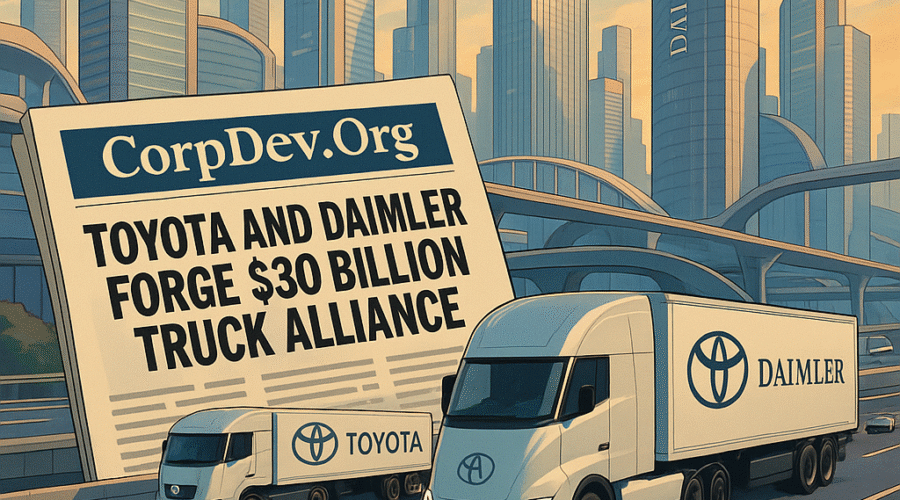The commercial vehicle sector witnessed a tectonic shift on June 10, 2025, as Toyota Motor Corporation and Daimler Truck AG finalized plans to merge their Japanese truck subsidiaries – Hino Motors and Mitsubishi Fuso – under a new Tokyo-based holding company. This landmark agreement, valued at approximately ¥4.5 trillion ($30 billion), creates Asia’s largest commercial vehicle manufacturer with combined annual revenues exceeding ¥5.8 trillion[1][3][7]. The merger positions the alliance to lead technological transformation in autonomous driving, hydrogen propulsion, and electric vehicle (EV) infrastructure while addressing intensifying competition from Chinese manufacturers and evolving emissions regulations[8][15].
💼 Seasoned CorpDev / M&A / PE expertise
Architecture of the Mega-Merger
Ownership Structure and Governance
The transaction establishes a novel equity framework where Daimler Truck and Toyota each acquire 25% stakes in the new holding company, with voting rights capped at 19.9% for Toyota and 26.7% for Daimler to comply with Japanese antitrust regulations[10][13]. This balanced power-sharing model preserves operational independence while enabling resource pooling – Mitsubishi Fuso brings advanced diesel engine platforms and European market expertise, while Hino contributes Toyota’s hydrogen fuel cell technology and Asian distribution networks[9][15]. Karl Deppen, current CEO of Mitsubishi Fuso, will lead the combined entity, leveraging his 25-year Daimler Truck tenure to integrate corporate cultures[2][7].
Financial Engineering and Asset Transfers
Critical to the deal’s viability is Hino’s ¥150 billion ($1 billion) sale of its Hamura production facility to Toyota, a strategic move that reduces debt burdens while maintaining just-in-time manufacturing capabilities through leaseback arrangements[11][6]. The holding company plans an April 2026 Tokyo Stock Exchange listing, targeting a ¥3.2 trillion market capitalization that would rank it among Japan’s top 30 blue-chip firms[4][12]. Analysts project ¥210 billion in annual synergies by 2030 through consolidated R&D spending and optimized supply chains across 17 global plants[7][9].
Technological Imperatives Driving Consolidation
CASE Technology Roadmap
The merger accelerates development of Connected, Autonomous, Shared, and Electric (CASE) technologies, with joint investments exceeding ¥700 billion through 2030[7][15]. Immediate priorities include scaling production of Fuso’s eCanter electric light-duty truck and integrating Hino’s Prologue autonomous driving system across medium-duty platforms[9][13]. Hydrogen commercialization receives particular emphasis – the alliance aims to deploy 50,000 fuel cell trucks in Japan by 2035 using Toyota’s second-generation Mirai technology[15].
Battery Ecosystem Development
To counter Chinese dominance in EV batteries, the partners are establishing a ¥120 billion joint venture with Panasonic and GS Yuasa to develop solid-state battery packs specifically for heavy-duty applications[8][15]. This complements existing partnerships with CATL and LG Energy Solutions, creating a multi-source procurement strategy that mitigates geopolitical risks while targeting 500 km ranges for 40-ton semis by 2028[9].
Regulatory Hurdles and Market Realignment
Antitrust Scrutiny and Compliance
Japan’s Fair Trade Commission imposed stringent conditions for approval, requiring the merged entity to maintain separate sales channels for five years and share patented emissions technologies with domestic rivals Isuzu and UD Trucks[10][14]. European regulators are reviewing potential impacts on Daimler’s existing MAN Truck & Bus operations, with provisional approval contingent on firewall protocols between Asian and European R&D teams[13][14].
Asian Market Restructuring
The deal triggers realignment in Asia’s $380 billion commercial vehicle sector, prompting responses from competitors like Traton Group’s increased stake in Navistar and Volvo’s accelerated JV discussions with Dongfeng Motors[8][15]. Within Japan, the Hino-Fuso combination controls 68% of medium/heavy-duty truck sales, pressuring smaller players to seek alliances – industry sources suggest Suzuki may acquire remaining shares in UD Trucks from Isuzu[10][14].
Leadership and Cultural Integration Challenges
Management Team Composition
Karl Deppen’s leadership team blends Toyota’s lean manufacturing experts with Daimler’s global logistics specialists, creating a 14-member executive committee with strict 50-50 nationality parity[7][13]. Early initiatives include cross-company kaizen workshops and a unified digital twin platform for production optimization[9]. Retention bonuses totaling ¥45 billion aim to prevent talent drain to Chinese OEMs offering 30% salary premiums[8][14].
Labor Relations Strategy
With 40,000 employees across 12 countries, the merger avoids immediate layoffs through natural attrition and redeployment to growth areas like battery plants[3][7]. The new holding company commits ¥75 billion to reskilling programs focused on AI-driven maintenance and hydrogen safety protocols, partnering with Japan’s Ministry of Economy, Trade and Industry on certification standards[15].
Financial Markets Reaction and Valuation Outlook
Investor Sentiment Analysis
Tokyo Stock Exchange filings reveal sophisticated hedging strategies – Toyota purchased ¥300 billion in currency forwards to mitigate euro-yen volatility from Daimler’s exposure, while Daimler secured put options on 5% of its holding company stake[11][14]. Credit Suisse analysts project 12-15% IRR for both parents through 2030, assuming successful execution of the Asia-focused electrification roadmap[8][15].
Supply Chain Finance Innovations
The alliance launches a blockchain-based supplier financing platform with MUFG and Allianz, offering sub-1% interest rates to component makers adopting clean production standards[9][15]. This complements a ¥500 billion green bond program targeting Scope 3 emissions reduction across 12,000 tier-2 suppliers by 2035[7].
Conclusion: Redefining Global Trucking Paradigms
This historic merger transcends traditional industry consolidation, creating a template for cross-continental collaboration in the decarbonization era. By combining Toyota’s hydrogen expertise with Daimler’s autonomous driving capabilities, the alliance positions itself as the architect of next-generation freight ecosystems. Success hinges on navigating cultural integration challenges and accelerating technological commercialization – if executed effectively, the Hino-Fuso combination could capture 25% of the global zero-emission truck market by 2035, fundamentally reshaping logistics economics worldwide[7][9][15].
Sources
https://www.truckpartsandservice.com/trucks-trailers/class-3-6/article/15748123/daimler-truck-reaches-definitive-agreement-with-toyota-to-merge-hino-and-fuso, https://www.ttnews.com/articles/daimler-toyota-truck-units, https://newsroom.toyota.eu/daimler-truck-mitsubishi-fuso-hino-and-toyota-motor-corporation-conclude-definitive-agreements-on-integrating-mitsubishi-fuso-and-hino-motors/, https://abcnews.go.com/Business/wireStory/truck-units-toyota-daimler-reach-merger-deal-announced-122689818, https://1027wbow.com/2025/04/21/toyota-daimler-near-merger-of-truck-units-nikkei-asia-reports/, https://equipmentfinancenews.com/news/transportation/toyota-daimler-finalize-plan-to-merge-truck-units-in-2026/, https://www.daimlertruck.com/en/newsroom/pressrelease/daimler-truck-mitsubishi-fuso-hino-and-toyota-motor-corporation-conclude-definitive-agreements-on-integrating-mitsubishi-fuso-and-hino-motors-53091310, https://www.ainvest.com/news/toyota-hino-daimler-fuso-merger-shape-japan-automotive-future-2504/, https://truckandbusbuilder.com/article/2025/06/11/fuso-and-hino-to-finalise-merger-plans-in-2026, https://www.nippon.com/en/news/yjj2025061000772/, https://www.marketscreener.com/quote/stock/HINO-MOTORS-LTD-6492560/news/Toyota-Motor-Corporation-executed-the-share-transfer-agreement-to-acquire-Hamura-Plant-of-Hino-Motor-50208247/, https://www.powerprogress.com/news/partners-announce-integration-of-mitsubishi-fuso-and-hino-motors/8062740.article, https://www.autoindustriya.com/truck-bus-news/official-fuso-toyota-s-hino-to-form-truck-merger.html, https://theexchangeasia.com/toyota-and-daimler-near-merger-of-truck-units-eyes-on-2026-listing/, https://motoring-trends.com/commercial-vehicles/mitsubishi-fuso-and-hino-motors-to-merge-under-new-holding-company-by-2026





